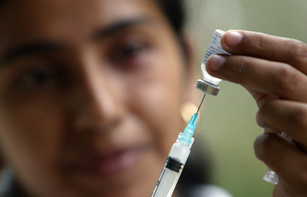
Credit: UNAIDS
There is broad scientific consensus that getting to zero new HIV infections will require an HIV vaccine. Modelling shows that even a partially effective HIV vaccine can save many lives and dollars over time.
Although a vaccine to prevent HIV could be the tool to quicken the pace to reach the end of AIDS, the quest for an effective vaccine has until now proved elusive. The very nature and variety of the human immunodeficiency virus has meant that it has resisted most attempts to quell its spread and scientists and vaccinologists the world over are focusing efforts on finding solutions.
Exciting recent developments in HIV vaccine research are instilling hope around finding an effective vaccine. In 2009, results from a trial in Thailand—RV144—showed a 31.2% vaccine efficacy in preventing HIV infections. Although only modestly protective, the results instilled new hope that an HIV vaccine could be found and made available for populations around the world most in need of a vaccine.
The results represented a significant scientific advance, and were the first demonstration that a vaccine can prevent HIV infection in a general adult population. It was a discovery of great importance and has been followed by more encouraging data in the last couple of years.
Data presented in the past year has been presented on the protective immune responses that were stimulated by the Thai vaccine trial. Trials are now planned to see if an RV144-like regimen will protect against a strain of HIV infection found in South Africa and against HIV acquisition by people at higher risk of exposure, specifically men who have sex with men.
UNAIDS and the US Centers for Disease Control worked closely with modelling teams to estimate the impact of the RV144 regimen in different countries and with different populations and found that 10% of infections could be prevented if the same 31% efficacy was found in people who receive the vaccine. This shows that a modestly effective HIV vaccine could add to the prevention toolbox of partially effective methods, hastening the decline of the HIV epidemic.
These and other advances in HIV vaccine development—including the design of new tools and technologies for vaccine delivery—have boosted optimism in the field about the prospects for the development of a safe and effective AIDS vaccine.
However, early data from the HIV Vaccines and Microbicides Resource Tracking Working Group is showing that a downturn in HIV vaccine funding that began in 2008 continued through 2011. The quest for effective HIV vaccines is a long-term investment in both the product (vaccines) and in the people who will develop, produce, market and support them. Investments in research and trials are essential and can bring benefits far beyond the AIDS field.
The need for a vaccine to prevent HIV is clear. Today, as we commemorate World AIDS Vaccine Day, there are in excess of 34 million people living with HIV, and every day more than 7000 people are becoming newly infected with the virus. Although a vaccine may not provide the magic bullet to end the AIDS epidemic, it would provide an additional tool to add to the robust package of HIV prevention options which are now available.
UNAIDS will continue to work with multiple partners––scientific communities, national and international AIDS research agencies, the pharmaceutical industry, private foundations, member states, and affected communities––to push the HIV vaccine agenda forward and ensure that the quest for a safe and effective HIV vaccine continues.




